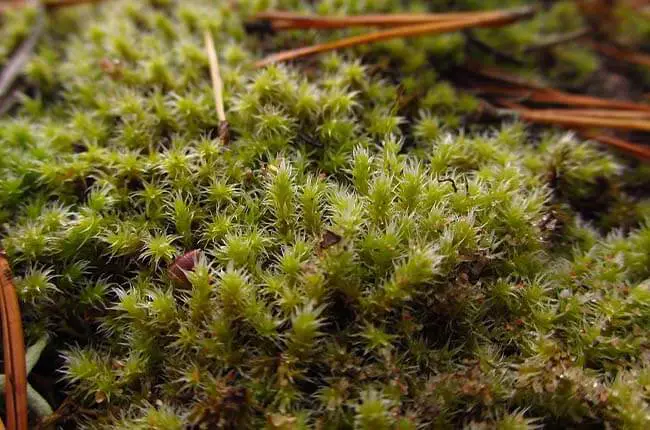Growing mosses indoors is becoming increasingly popular. Not only are they low-maintenance and always green, they can also improve indoor air quality.
Mosses can be used as potting material for orchids, to topdress or accompany plants with similar growing habits, or as a living wall to create a unique and natural touch in your home.
In this article, we will introduce you to a list of mosses that can be grown indoors and provide tips for caring for them.
Cushion mosses
These are small mosses that grow into the shape of a cushion, with branches growing closely together and overlapping. The stems are short and upright, and the leaves are densely packed.
1. Broom Fork Moss (Dicranum scoparium)
The Broom Fork Moss has a dense and bushy growth habit, forming clumps that can grow up to 4 inches (10 cm) tall.
Its stem is reddish-brown, and its leaves are light green when young, darkening to a yellow-green as they mature.
The stems are thin and the leaves are narrow, lance-shaped, and curved to one side with a pointed tip.
It grows vertically, typically found growing on soil, rocks, logs, and tree trunks in shaded and moist environments.
Care tips: Broom Fork Moss prefers a shaded, humid environment with consistent moisture. It can tolerate dry periods but will quickly recover once rehydrated. It can be grown indoors in a well-lit area with indirect sunlight and high humidity, such as on a living wall or as a top dressing for houseplants. To ensure proper growth, mist the moss regularly, or place it in a tray with water and rocks to maintain humidity levels

(Michel Langeveld, CC BY-SA 4.0, via Wikimedia Commons)
2. Mossy Grimmia (Grimmia pulvinata)
Mossy Grimmia grows like a round cushion that can measure up to 2 inches (5 cm) tall and 6 inches (15 cm) wide.
It has a bright green color when moist, and brownish-green when dry.
The stems are short, thick, and reddish-brown, and the leaves are oval-shaped, pointed, and tightly packed together, giving the moss a velvety appearance.
It spreads horizontally, typically found growing on rocks, soil, and tree bark in shaded and moist environments.
Care tips: Mossy Grimmia prefers a shaded, humid environment with consistent moisture. It can tolerate dry periods but will quickly recover once rehydrated. It can be grown indoors in a well-lit area with indirect sunlight and high humidity, such as on a living wall or as a top dressing for houseplants.
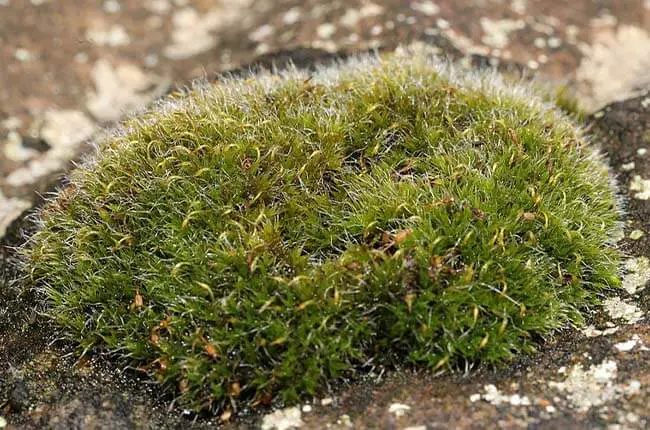
(Stephen James McWilliam, CC BY 4.0, via Wikimedia Commons)
3. Pincushion Moss (Leucobryum glaucum)
Pincushion Moss has a round, puffy shape that resembles a small cushion or a pin cushion.
Its stems are thin and delicate and can grow up to 2-3 inches (5 – 7.6 cm) tall. The branches are short and stubby, and radiate out from the center in all directions.
The leaves are small, needle-like, and arranged in a spiral pattern around the stem, giving the plant a unique, symmetrical appearance.
Care tips: Pincushion Moss requires moist, well-drained soil that is rich in organic matter. It prefers shady areas with high humidity, and it can be grown indoors in a terrarium or on a living wall. The plant does not tolerate direct sunlight or dry soil, so it should be kept in a humid environment with indirect light.
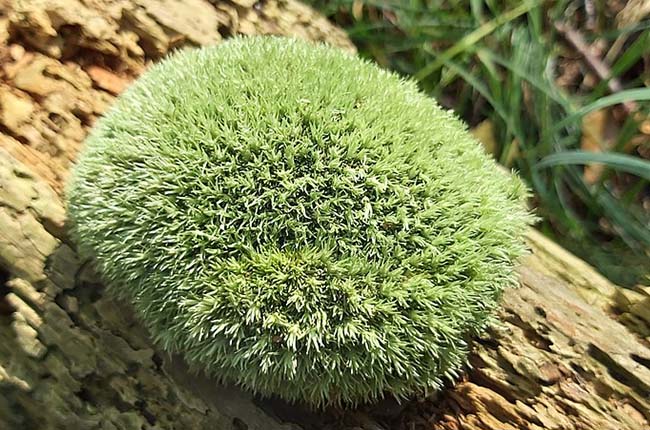
(Tomas Pocius, CC0, via Wikimedia Commons)
Turf mosses
Turf mosses grow in dense mats, with upright branches that are less densely packed than cushion mosses. They often grow in clumps or tufts, and the leaves are arranged in a spiral pattern around the stem
4. Fire moss (Ceratodon purpureus)
Ceratodon purpureus, also known as Redshank or Fire Moss, has a distinctive bright green color that can turn reddish-brown in dry conditions, making it a popular choice to add vibrant color to indoor spaces.
Its upright growth habit can reach to a mature height of 2-5 cm and a width of 10-20 cm. Its leaves are narrow and pointed and its stems are tall and slender.

(Braden J. Judson, CC0, via Wikimedia Commons)
5. Haircap Moss (Polytrichum commune)
Polytrichum commune, also known as Haircap Moss, is special for its tall, spiky appearance.
It has a distinctive, upright growth habit that typically grows to a mature height of 5-15 cm and a width of 10-20 cm.
The moss is a dark green color, with leaves that are long and pointed. The stems are tall and slender, and the plant grows in a dense, upright habit.

(Robme66, CC BY-SA 4.0, via Wikimedia Commons)
6. Feather moss (Pseudoscleropodium purum)
What makes Pseudoscleropodium purum special is its feathery, fern-like appearance. Its upright growth habit also makes it a popular choice for use in living walls or as a decorative accent in indoor gardens.
It typically grows to a mature height of 5-10 cm and a width of 10-20 cm. It is a bright green color, with leaves that are narrow and pointed and thin and delicate stems.
Care tips: When growing Pseudoscleropodium purum indoors, it requires bright, indirect light and moderate moisture levels.
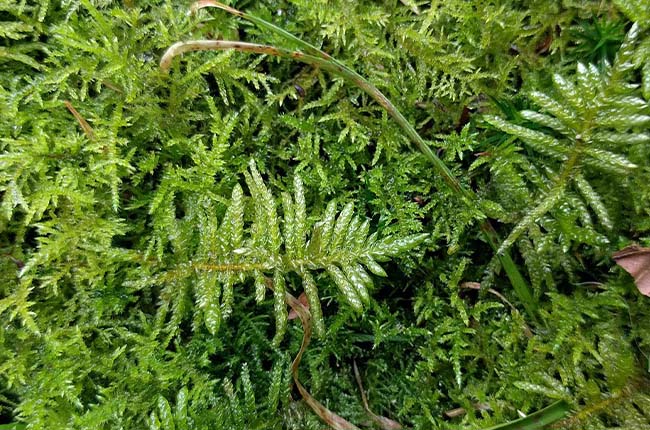
(Michel Langeveld, CC BY-SA 4.0, via Wikimedia Commons)
Weft mosses
Weft mosses grow in flat, horizontal mats or carpets, with branches growing out in all directions. The leaves are often long and narrow, and they can be tightly packed or widely spaced.
7. Sheet moss (Hypnum cupressiforme)
Hypnum cupressiforme, also known as Sheet Moss, is special for its flat, sheet-like appearance, making it a popular choice for use as a ground cover or as a decorative accent in indoor gardens.
It typically grows to a mature height of 2-5 cm and a width of 10-20 cm.
The moss is a bright green color, with leaves that are narrow and pointed. The stems are thin and delicate, and the plant grows in a flat, spreading habit.
When growing Hypnum cupressiforme indoors, it requires bright, indirect light and moderate moisture levels.

(Susan Marley, CC BY 4.0, via Wikimedia Commons)
8. Snake moss (Plagiothecium undulatum)
Snake moss has a long distinctive, snake-like appearance.
It typically grows to a mature height of 5-10 cm and a width of 10-20 cm. Its stems are long with leaves that are narrow and pointed.
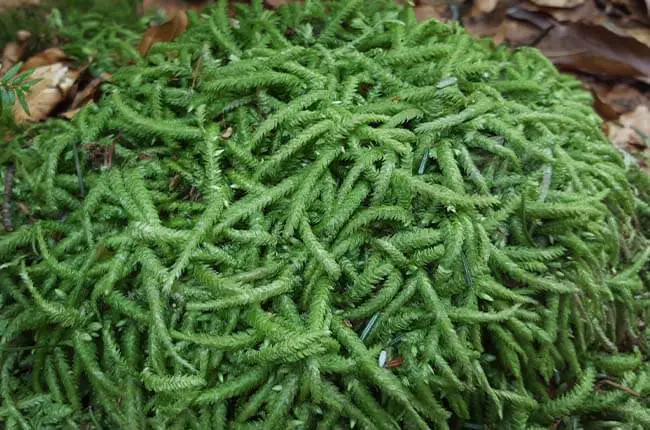
(Honymand, CC BY-SA 4.0, via Wikimedia Commons )
9. Hoary-fringe moss (Racomitrium canescens)
Hoary-fringe moss is a small, dull, yellow-green plant that grows in clumps in a mat-like appearance with short side branches and white hair points on the leaves.
The stems are about 1-2 inches (2-4 cm) tall and the tiny leaves are about 2 mm long and 0.5 mm wide.
The plant grows vertically and requires bright, well-lit, rapidly drying habitats. It is typically found on rocks and exposed open banks of roads, especially after rainfall.
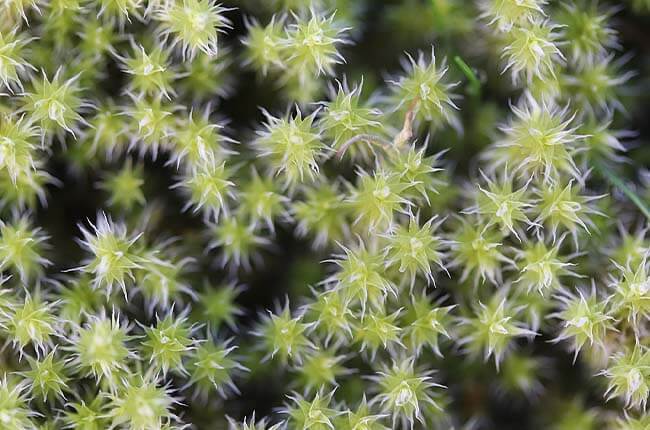
(Marko Vainu, CC BY-SA 3.0, via Wikimedia Commons)
Acrocarpous mosses
Acrocarpous mosses have an upright growth form, with vertical stems that produce leaves and branches in a more erect fashion. They grow in a tight, compact form, and the branches arise from a central point at the top of the stem.
10. Silvery Thread moss (Bryum argenteum)
What makes Bryum argenteum special is the tiny, silvery-white hairs that cover the entire plant, giving it a unique shimmering look when it catches the light.
It has a loosely tufted growth habit with thin and delicate stems that can reach up to 1 inch (2.5 cm) in length. The leaves are small, narrow, and triangular in shape, and have a bright green color that contrasts with the silvery hairs.
The moss has a creeping growth habit spreading horizontally like a mat.
It prefers moist environments and can thrive in shady or partially shaded areas.

(Randal, CC0, via Wikimedia Commons)
11. Smoothcap moss (Atrichum undulatum)
Smoothcap moss is a medium-sized moss that forms dense, loose cushions or tufts on soil, humus, and rocks.
It has a unique appearance due to its green, wavy leaves that with a lanceolate shape and a pointed tip.
The stems are about 2-6 inches (5-15 cm) long and are usually hidden by the leaves. The plant grows vertically and can reach a height of up to 8 inches (20 cm).
It is commonly found in damp and shady areas, especially in woodlands and bogs.
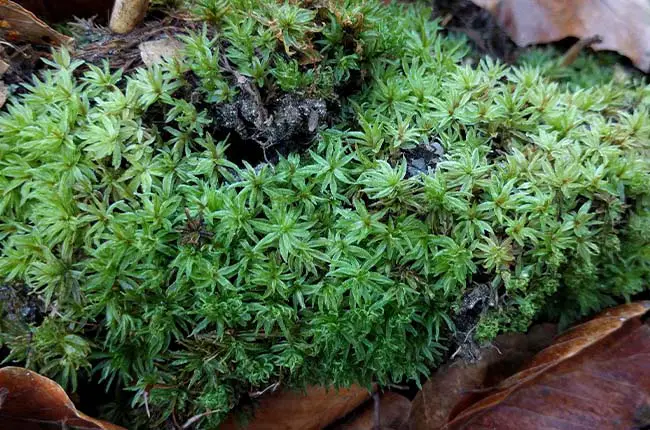
(Michel Langeveld, CC BY-SA 4.0, via Wikimedia Commons)
12. Hart’s tongue thyme moss (Plagiomnium undulatum)
Plagiomnium undulatum is unique for its bright green color and wavy or undulating leaves which are about 2-4 mm long and 1-2 mm wide, with a lanceolate shape and a pointed tip.
The stem is about 2-6 cm long and 1-2 mm wide, and it is usually hidden by the leaves. The plant grows vertically and can reach a height of up to 10 cm.
It is a small to medium-sized moss that forms dense, loose cushions or mats on soil, humus, and rocks.

HermannSchachner, CC0, via Wikimedia Commons
Pleurocarpous mosses
Pleurocarpous mosses have a prostrate growth form and typically have a creeping habit. The branches of pleurocarpous mosses arise from lateral buds along the stem and grow horizontally. As a result, they often form extensive mats or carpets.
13. Stairstep moss (Hylocomium splendens)
Hylocomium splendens, commonly known as splendid feather moss or stairstep moss, is a medium to large-sized moss that forms dense, loose cushions or mats on soil, humus, and rocks.
It has a unique appearance due to its bright green color and its characteristic stairstep feathery growth pattern.
The leaves are about 2-3 cm long, with a lanceolate shape and a pointed tip. It has long stems about 4-8 inches (10-20 cm) long.
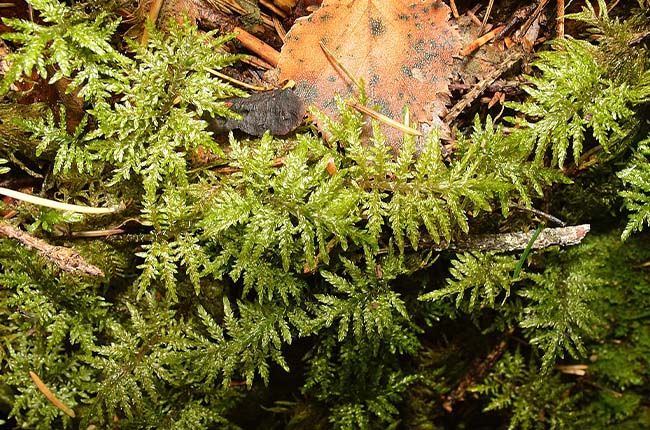
(Ryan Hodnett, CC BY-SA 4.0, via Wikimedia Commons)
14. Fern Moss (Thuidium delicatulum)
Fern Moss has a unique appearance due to its feathery, fern-like leaves that are arranged in a flat, spreading pattern.
It is a small to medium-sized moss that forms dense, loose cushions or mats on soil, humus, and rocks.
The leaves are about 1-2 cm long and 1-2 mm wide with a pointed tip and the stems are about 2-4 cm long.
The plant grows horizontally and can reach a width of up to 30 cm. It is commonly found in damp and shady areas, especially in woodlands and bogs.

(James St. John, CC BY 2.0, via Wikimedia Commons)
15. Sheet Moss (Hypnum cupressiforme)
Hypnum cupressiforme is a small to medium-sized moss with branched stems and overlapping leaves, which makes it look like the leaves of a cypress tree.
It grows horizontally and forms a dense mat of interwoven stems and leaves.
Care tips: It prefers moist environments and can tolerate a wide range of light conditions, from partial shade to full sun.
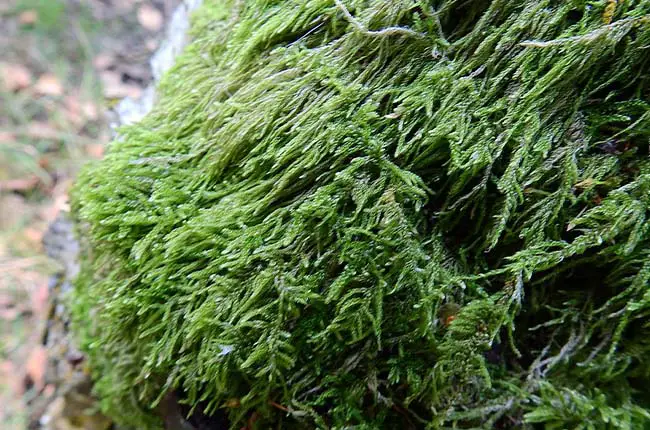
(Susan Marley, CC BY 4.0, via Wikimedia Commons)
Epiphytic mosses
Epiphytic mosses grow on other plants or objects, such as tree trunks or rocks.
They often have specialized structures that help them attach to their host and absorb moisture and nutrients from the air.
16. Spanish Moss (Tillandsia usneoides)
Spanish Moss is an epiphytic plant, which means it grows on other plants but is not parasitic. It does not have roots, and it absorbs moisture and nutrients from the air through its leaves.
The plant has a unique appearance due to its long, thin, and wiry stems that are covered in silvery-gray scales.
Its stems can grow up to 20 feet (6 meters) long, and they can form dense mats or curtains that hang from trees or other structures.
Care tips: Spanish moss requires bright, indirect light and high humidity. The plant should be misted regularly to keep it moist, and it can be soaked in water once a week to provide it with additional moisture.
It does not require soil, but it can be attached to a piece of wood or other structure using wire or string. It is a hardy plant that can tolerate a wide range of temperatures, but it prefers a temperature range of 15-30°C.
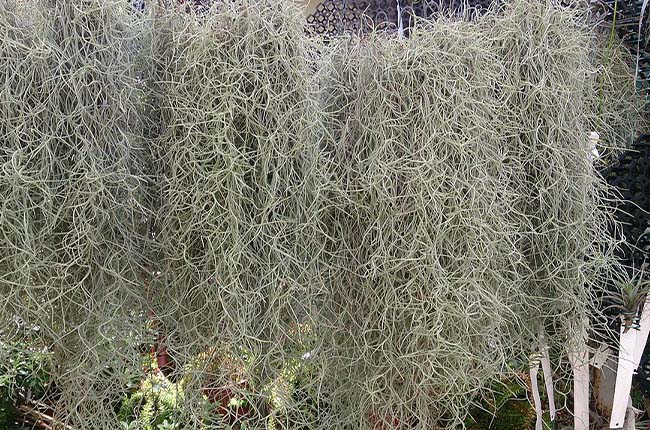
(Mokkie, CC BY-SA 3.0, via Wikimedia Commons)
Can you grow all types of moss indoors?
Not every moss is suitable to grow indoors because it is difficult to replicate the conditions of the natural habitat they grow in.
Mosses that are considered more challenging to grow indoors are those that require high moisture, and may not tolerate dry indoor conditions or fluctuations in temperature well.
Examples include:
- Sphagnum fimbriatum (Fringed Bogmoss)
- Pohlia nutans
- Plagiomnium affine
- Rhizomnium punctatum
- Climacium dendroides (Tree Climbing Moss)
- Isothecium myosuroides (Rough-stemmed Feather-moss)
- Pseudotaxiphyllum elegans (Elegant Pseudotaxiphyllum Moss)
- Thelia hirtella (Rough-stemmed Thelia Moss)
- Polytrichastrum alpinum
Others are more challenging to grow because of their preference for cool temperatures, e.g. Aulacomnium palustre (Swamp Bristle-moss), Ceratodon conicus.
But ultimately, the success of growing any moss species indoors depends on providing the appropriate growing conditions and care for that specific species.
Happy gardening!
Related
Top 19 Plants That Grow Well With Moss
Growing Orchids with Live Moss? (Pros & Cons Examined)
- Keiki Paste vs Rooting Hormone:What’s the difference? - February 4, 2024
- Top 10 Orchid Fertilizers: A Comprehensive Review (2024) - February 2, 2024
- Top 8 Soil Inoculants For Stronger Plants (2024) - February 1, 2024

